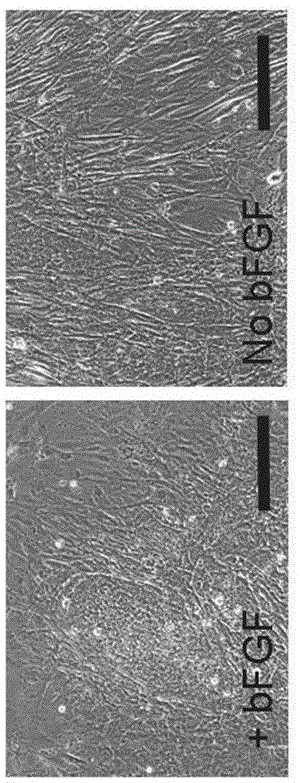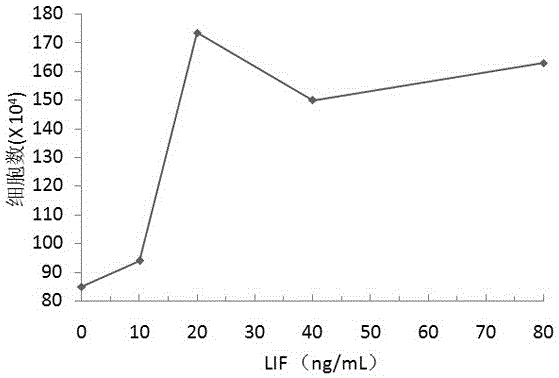Composition for embryonic stem cell culture and application thereof
A technology of embryonic stem cells and cell culture, applied in embryonic cells, germ cells, animal cells, etc., can solve the problem of not being able to maintain the characteristics of embryonic stem cells for a long time
- Summary
- Abstract
- Description
- Claims
- Application Information
AI Technical Summary
Problems solved by technology
Method used
Image
Examples
Embodiment 1
[0053] Experiment 1: A control experiment of raising rabbit embryos in medium with or without bFGF supplementation.
[0054] The basal culture medium of rabbit embryonic stem cells is KnockOutDMEM (Invitrogen, USA) supplemented with 20% fetal bovine serum, 0.1mM non-essential amino acids, 0.1mM β-mercaptoethanol (Millipore, USA), 4mM glutamine, 50 units / mL penicillin , 50 μg / mL streptomycin.
[0055] Add 10 ng / mL LIF (Millipore, USA) and 10 ng / mL bFGF (Invitrogen, USA) to the basal culture medium, hereinafter referred to as FL culture system.
[0056] Add 10 ng / mL LIF (Millipore, USA), 10 ng / mL bFGF (Invitrogen, USA), 10 μM Y27632, 100 ng / mL Noggin to the basal culture medium, hereinafter referred to as iFLY culture system.
[0057] Only LIF was added to the basal culture medium without bFGF as the control group (no bFGF).
[0058] New Zealand rabbits (purchased from Nanjing Jinling Breeding Rabbit Farm) were treated with superovulation, that is, a total of 2.4 mg of follicl...
Embodiment 2
[0086] Experiment 1': Establishing a rabbit embryonic stem cell line using the iFLY culture system.
[0087] The composition of the iFLY culture system is the same as above. As shown in Figure 2A, after the embryos were cultured in iFLY, stem cell-like growth occurred two days later (D2), and the cells grew more densely after 5 days, and the morphology showed the characteristics of stem cells (D5). After one passage (P1), the induced stem cells produced obvious stem cell morphology ( Figure 2A ). In addition, experiments have shown that both fresh and frozen blastocysts can be cultured in the iFLY culture system to obtain rabbit embryonic stem cells (10.2% vs. 16.9%), as shown in Table 5. After the frozen embryos at the 1-2 cell stage were thawed and then cultured into blastocysts, the efficiency of rabbit embryonic stem cell induction dropped to 1.5%, as shown in Table 5.
[0088] Table 5 Effects of fresh embryos and frozen embryos on the acquisition of rabbit embryonic st...
Embodiment 3
[0107] Experiment 1'': rabbit embryonic stem cell line #7-1, M5 blastocyst injection experiment.
[0108] Rabbit embryonic stem cell line #7-1 (iFLY system) and stem cell line M5 (FL system) were used for blastocyst injection to generate chimeric animals. Blastocysts of wild-type New Zealand rabbits were used as recipient embryos for cell injection, #7-1 and M5 cells were infected with GFP DNA cells using the green fluorescent (GFP) Fugene conversion system (Roche, USA), so that the stem cell genome carried the GFP gene, and GFP protein is expressed in cells; under a fluorescent microscope, it shows green fluorescence. Cells from a successfully infected GFP cell line (#7-1, M5) were microinjected into wild-type blastocysts, and approximately 5-10 stem cells were injected into each blastocyst. About 10-20 injected blastocysts were transplanted into estrus-synchronized female rabbits, and the ears of newborn rabbits were sampled for PCR detection of GFPDNA. At the same time, e...
PUM
 Login to View More
Login to View More Abstract
Description
Claims
Application Information
 Login to View More
Login to View More - R&D
- Intellectual Property
- Life Sciences
- Materials
- Tech Scout
- Unparalleled Data Quality
- Higher Quality Content
- 60% Fewer Hallucinations
Browse by: Latest US Patents, China's latest patents, Technical Efficacy Thesaurus, Application Domain, Technology Topic, Popular Technical Reports.
© 2025 PatSnap. All rights reserved.Legal|Privacy policy|Modern Slavery Act Transparency Statement|Sitemap|About US| Contact US: help@patsnap.com



